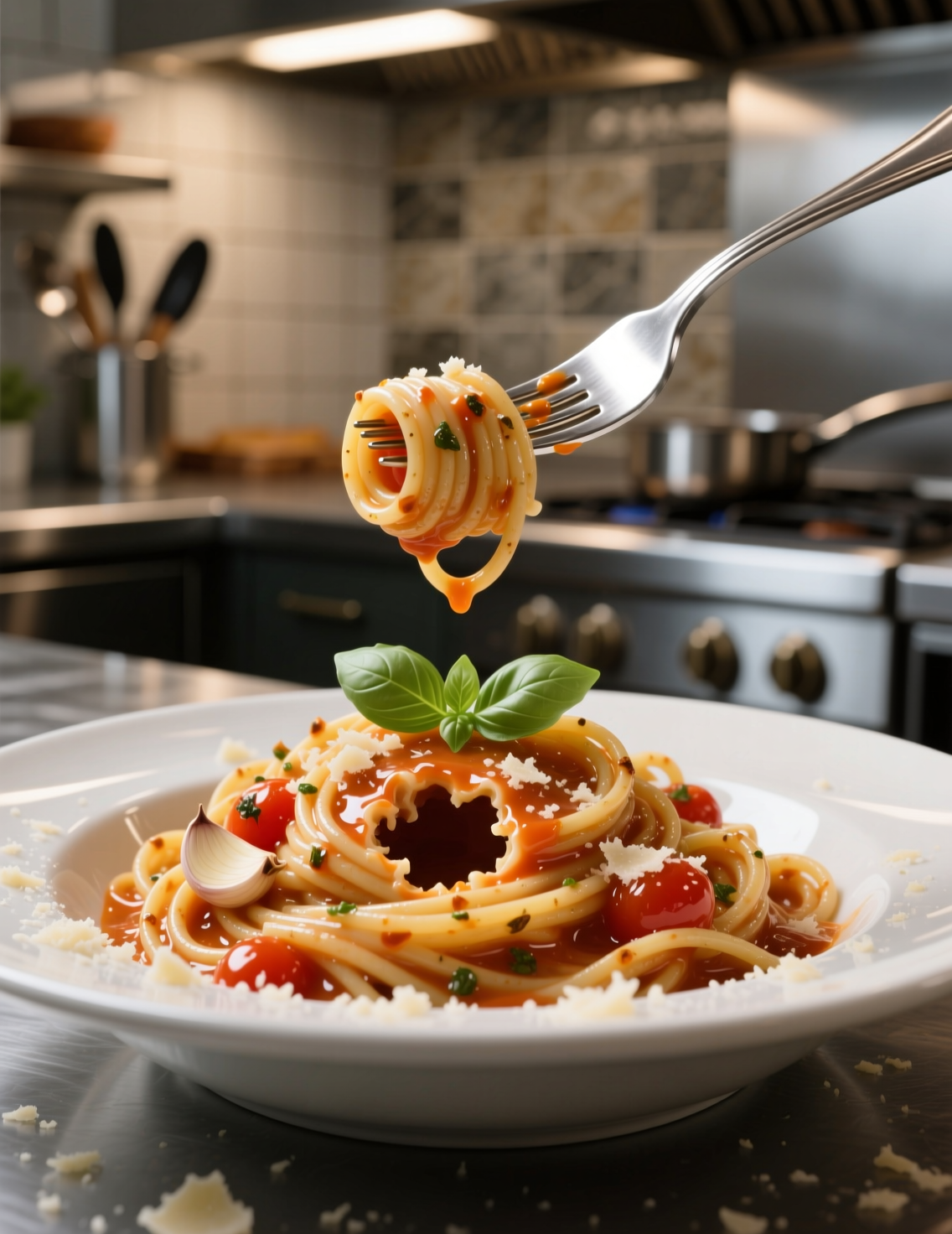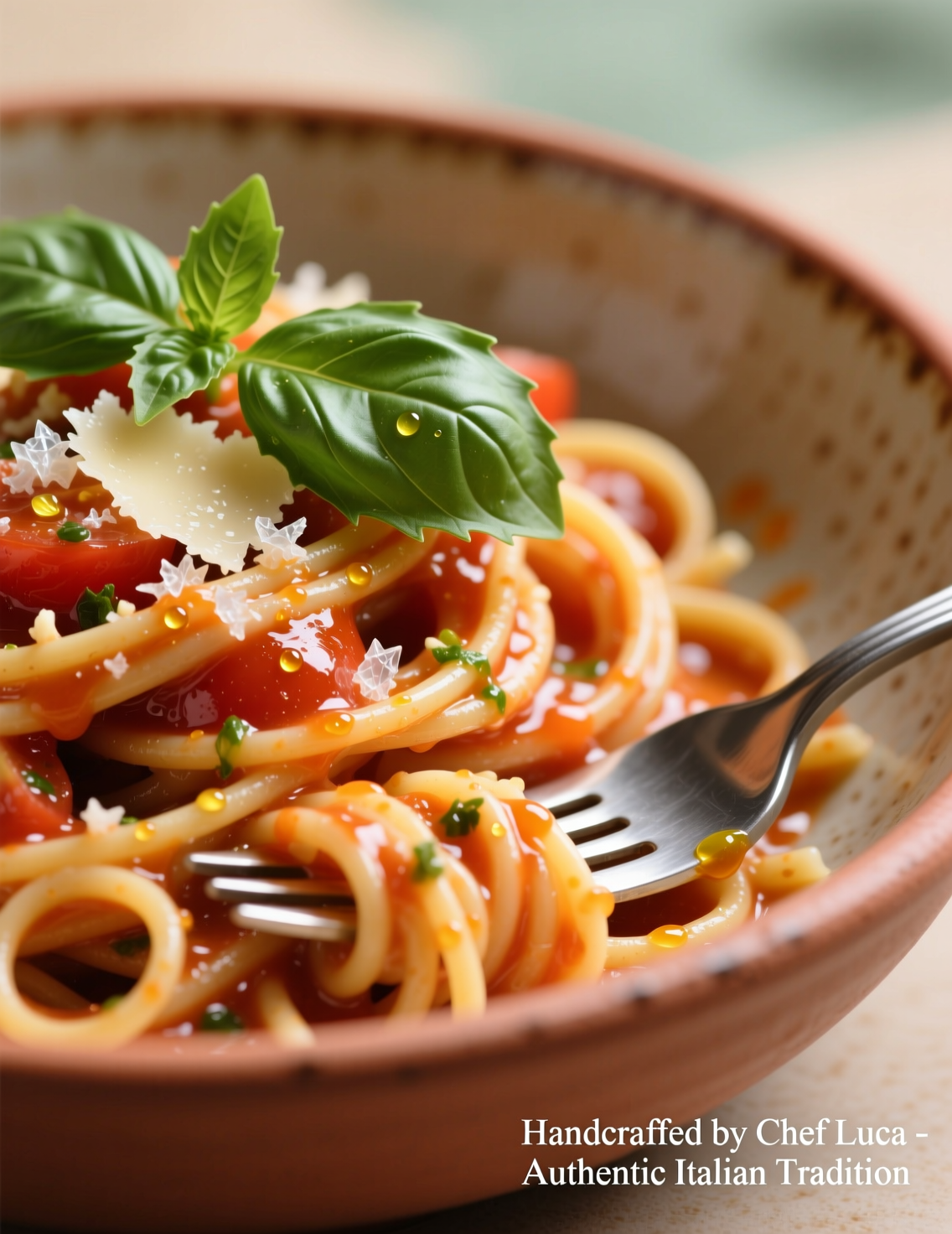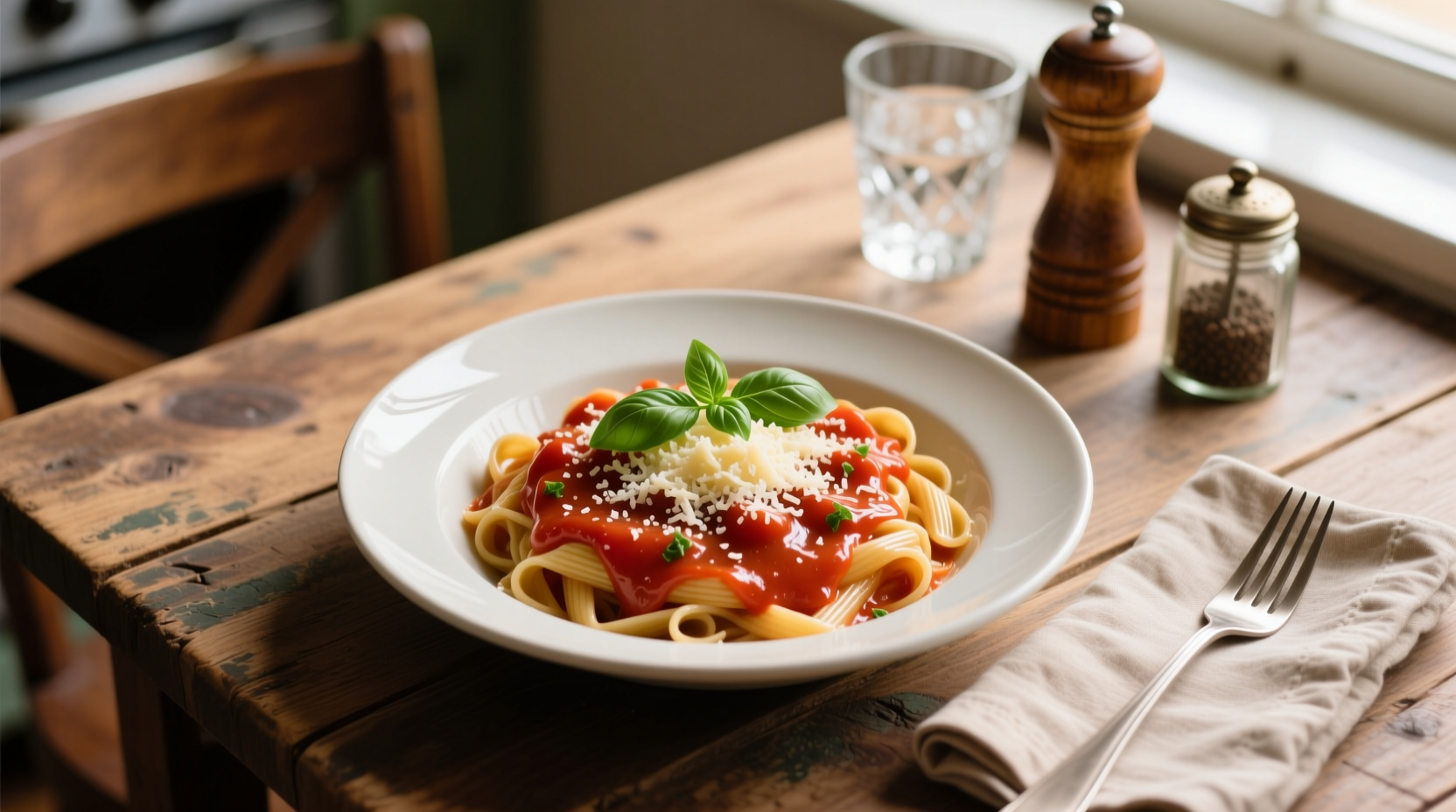Pasta is simple, but pasta done right—well, it’s alchemy. This Creamy Tomato Garlic Pasta recipe isn’t just dinner on a Tuesday night, it’s the kind of dish that holds its own on a restaurant menu. I’ll show you not only how to make it, but also the why behind each step, because a great plate of pasta doesn’t happen by accident.
Why Creamy Tomato Garlic Pasta Works So Well
Tomato and garlic are old companions. Garlic brings pungency, tomato balances with acidity, and when cream enters the room, it softens the whole equation into something luxurious. A starch-based carbohydrate like pasta needs fat and acid to feel complete on the palate. That’s culinary science wrapped in a forkful.
What makes this specific dish stand out is texture. Silky cream binds the sauce, while pasta starch builds body without extra thickeners. It’s a one-pan masterclass in emulsification if you know what to watch for.
Ingredients and Their Professional Roles
Every ingredient matters more than people think. You can’t just throw cream, tomatoes, and garlic together and hope it works. Here’s what you actually need for 4 servings:
- Pasta (400 g dry, ideally linguine or rigatoni): Shapes with surface texture grip sauce better. Smooth spaghetti sheds sauce faster.
- Olive oil (2 tbsp): Neutral enough to carry garlic without burning it, but still adds fruitiness.
- Garlic (6 large cloves, finely minced): You want garlic to perfume the oil, not dominate. Timing is key.
- Canned San Marzano tomatoes (1 large 28 oz can): They break down into a smoother sauce with lower bitterness. This matters more than you’d expect.
- Heavy cream (1 cup): Anything under 36% fat risks curdling when heat spikes. Professionals never gamble here.
- Parmesan cheese (1/2 cup grated, plus extra for garnish): The umami that ties everything. Avoid pre-grated—its anti-caking agents ruin emulsification.
- Salt (to taste, but start at 1 tsp): Pasta water should taste like the sea, not a puddle.
- Fresh basil (8–10 leaves, torn by hand): Adds a volatile, bright note that heat alone can’t replicate.
- Black pepper (freshly cracked, 1/2 tsp): Adds aromatic spice without overwhelming.
Optional but wise: a pinch of sugar. It tempers acidity in tomatoes, particularly if they’re not peak season or true San Marzano.

Technique Over Recipe
Anyone can follow a recipe card. Professionals focus on technique. Here’s where 90% of home cooks go wrong:
Cooking the Pasta
Salt your water like you mean it. A tablespoon of salt per 4 liters of water is not excessive—it’s standard. Pasta absorbs salt only while cooking, not after. Underseasoned pasta tastes flat no matter how perfect the sauce. Cook until just al dente. You want a little chew left because it will finish cooking in the sauce.
Building the Sauce Base
Garlic must hit warm oil, not smoking oil. If the pan is too hot, garlic jumps from golden to bitter in seconds. Professionals swirl the pan often, coaxing out flavor without scorching. Tomatoes go in once garlic smells sweet. You don’t rush it. Allow them to simmer and reduce—at least 12 minutes. That reduction concentrates flavor and drives off harsh acidity.
Cream Integration
The cream enters when the tomato base is stable. Add it too early, and acid can curdle it. Add it too late, and it won’t bind. Medium-low heat, a slow pour, constant stirring. That’s the dance.
Pasta and Sauce Marriage
Drain pasta but never rinse. The starch is liquid gold. Transfer pasta directly into the pan with sauce. Add a ladle of pasta water, then toss vigorously. Professionals don’t “coat” pasta—they emulsify sauce into it. A few minutes of tossing creates that glossy cling people mistake for “restaurant magic.”
Flavor Balance and Adjustments
The tricky part of creamy tomato garlic pasta is balance. Too much cream, and it becomes flat and heavy. Too little, and acid from tomato dominates. Professionals adjust in three ways:
- Salt: Taste in stages. Tomatoes absorb more seasoning than cream, so final adjustments often happen after cream addition.
- Acid: If it tastes dull, a squeeze of lemon or splash of white wine wakes it up.
- Fat: If sauce feels thin, swirl in cold butter off the heat. Classic French finish, but it works beautifully in Italian-inspired dishes.
Scaling for Consistency
In professional kitchens, scaling isn’t just math—it’s chemistry. If you double the recipe, tomato reduction time must also increase. Liquids don’t reduce at the same rate when volume changes. Cream must be warmed separately in large batches to avoid curdling. That’s why you can’t just “x2” a sauce and expect identical results.
For 4 servings, 1 cup cream balances with one large can of tomatoes. For 8 servings, you may need 2.5 cups cream, not 2. Exact ratios bend with surface area, pan size, and evaporation. Professionals watch texture, not measuring cups.
Common Mistakes to Avoid
- Overcooking garlic: Once bitter, you can’t rescue it. Start over.
- Rushing tomato reduction: Raw, tinny flavor ruins the sauce. Let it simmer down.
- Pouring cream into boiling sauce: This will split it. Reduce heat first.
- Drowning pasta in sauce: The pasta should be dressed, not swimming. Think glossy, not soupy.
Expert Tips for Extra Depth
If you want the dish to sing louder, a few chef-level tricks elevate it:
- Roast garlic instead of sautéing: Sweeter, deeper flavor profile.
- Use a parmesan rind in the tomato simmer: Old-school trick for complexity. Remove before adding cream.
- Infuse olive oil with chili flakes first: Subtle heat that doesn’t overpower.
- Blend half the sauce smooth before adding cream: Creates a velvet texture, then fold in the chunkier half for contrast.

Nutritional and Culinary Insights
A serving of creamy tomato garlic pasta for four balances macronutrients fairly well. Carbs from pasta provide energy. Cream and olive oil supply fat—rich but necessary for satiety. Tomatoes bring lycopene, a powerful antioxidant that becomes more bioavailable when cooked. Garlic contributes allicin, known for cardiovascular benefits, though heat reduces potency.
From a caloric standpoint, one serving hovers around 550–600 calories, depending on cheese quantity. That’s on par with restaurant pasta but significantly healthier when you control the oil and cream. Professionals recognize that indulgence balanced with nutrient density matters.
Variations Across Culinary Traditions
This dish doesn’t live in a vacuum. Italian-American kitchens lean heavier on cream. In Italy, many chefs would argue tomato and cream should rarely meet, preferring pure pomodoro or alla vodka versions. French chefs see no problem—cream belongs everywhere.
In contemporary kitchens, chefs play with plant-based creams (cashew, oat) to mimic texture. When done carefully, it works, though the mouthfeel differs slightly. Data from the plant-based foods association shows a 20% rise in demand for non-dairy alternatives in pasta sauces since 2022. This trend isn’t going away.
Pairings and Professional Presentation
Serve this pasta with restraint. A simple green salad with lemon vinaigrette balances richness. For wine, a medium-bodied red like Chianti works, but so does a crisp Pinot Grigio. The acid cuts cream; the fruitiness echoes tomato.
Plate pasta by twirling portions with tongs into a nest shape. Garnish with basil leaves and fresh parmesan shavings. Drizzle a thread of good olive oil across the top. Presentation matters more than people admit—diners eat with their eyes first.
Frequently Asked Questions
Can I use fresh tomatoes instead of canned? Yes, but you’ll need to blanch, peel, and reduce them longer. Canned San Marzano remains more consistent.
Will light cream work? Not reliably. Light cream splits easier and doesn’t emulsify as well. Stick with heavy cream.
Is this the same as vodka sauce? Not quite. Vodka sauce uses alcohol to extract and release flavors locked in tomatoes and fat. This is creamier, less sharp.
Can I make it ahead? Sauce yes, pasta no. The sauce holds 2–3 days refrigerated. Always marry pasta and sauce fresh for service.
Conclusion
Creamy Tomato Garlic Pasta looks simple, but it hides layers of culinary science and technique. From emulsification to proper seasoning, every decision shapes the final plate. Professionals don’t just chase flavor—they control texture, balance, and chemistry.
For 4 servings, this recipe is both approachable and refined. Done right, it rivals what you’d get in a fine trattoria. The key takeaways? Respect your ingredients, master your heat, and never rush the sauce. Do that, and you’ll turn a humble plate of pasta into something unforgettable.
FAQs
Can I substitute canned tomatoes with fresh ones?
Yes, but blanch, peel, and reduce fresh tomatoes longer for proper flavor depth.
What type of pasta works best for this recipe?
Linguine, rigatoni, or any pasta with texture grips the creamy sauce best.
Is heavy cream necessary?
Yes, heavy cream prevents curdling and ensures a stable, velvety sauce.
Can I prepare the sauce ahead of time?
Yes, the sauce lasts 2–3 days refrigerated, but cook pasta fresh.
How do I stop the garlic from burning?
Start garlic in warm oil and stir constantly to keep it golden, not bitter.
Is this dish similar to vodka sauce?
No, vodka sauce uses alcohol for sharpness, while this is richer and creamier.
Can I make this dish lighter?
You can reduce cream or use plant-based alternatives, though texture changes.
How much salt should I add to pasta water?
Roughly 1 tablespoon per 4 liters—pasta water must taste like the sea.
What wine pairs best with creamy tomato garlic pasta?
A Chianti or Pinot Grigio balances the acidity and richness perfectly.
Why shouldn’t pasta be rinsed after boiling?
Rinsing washes away starch that’s crucial for sauce emulsification.

Mariana is a passionate home cook who creates delicious, easy-to-follow recipes for busy people. From energizing breakfasts to satisfying dinners and indulgent desserts, her dishes are designed to fuel both your body and hustle.
When she’s not in the kitchen, she’s exploring new flavors and dreaming up her next recipe to share with the Foodie Hustle community.

